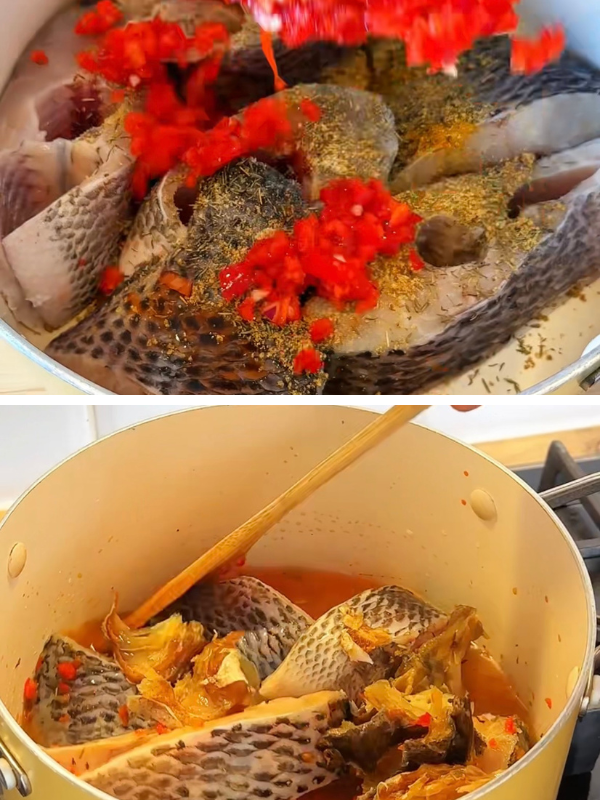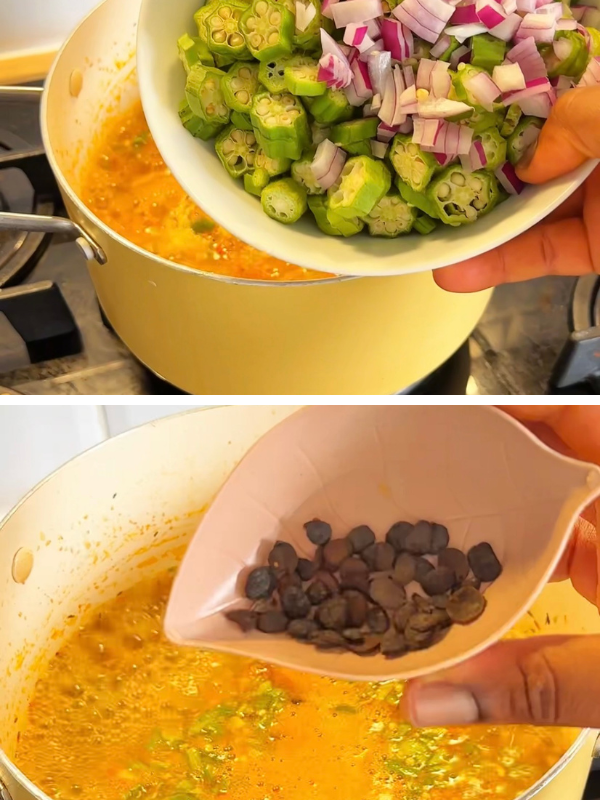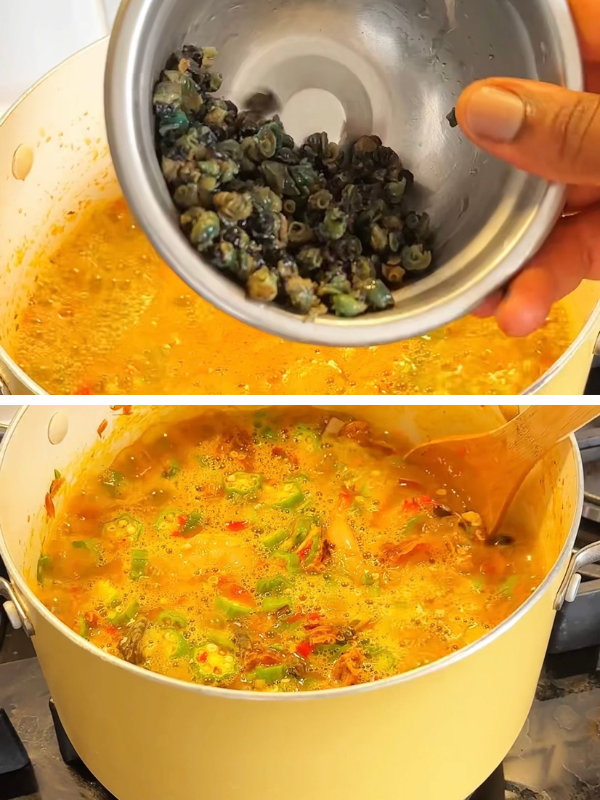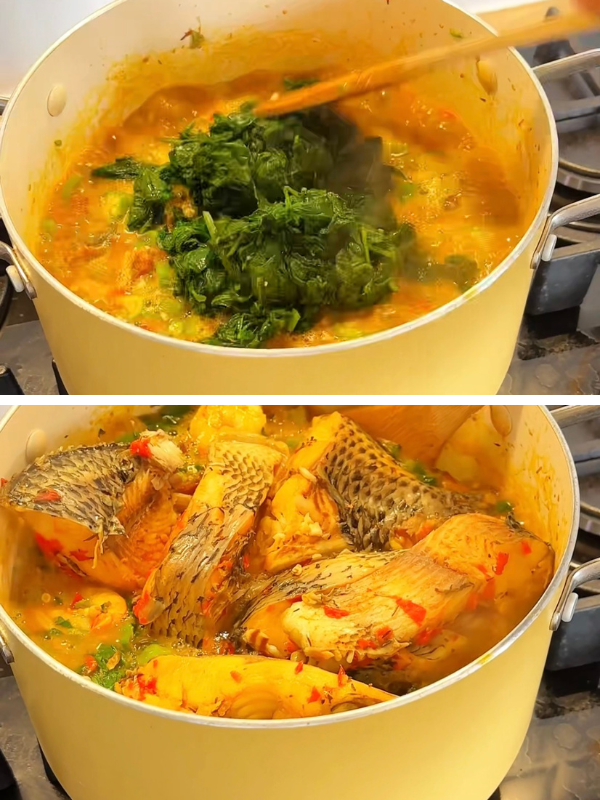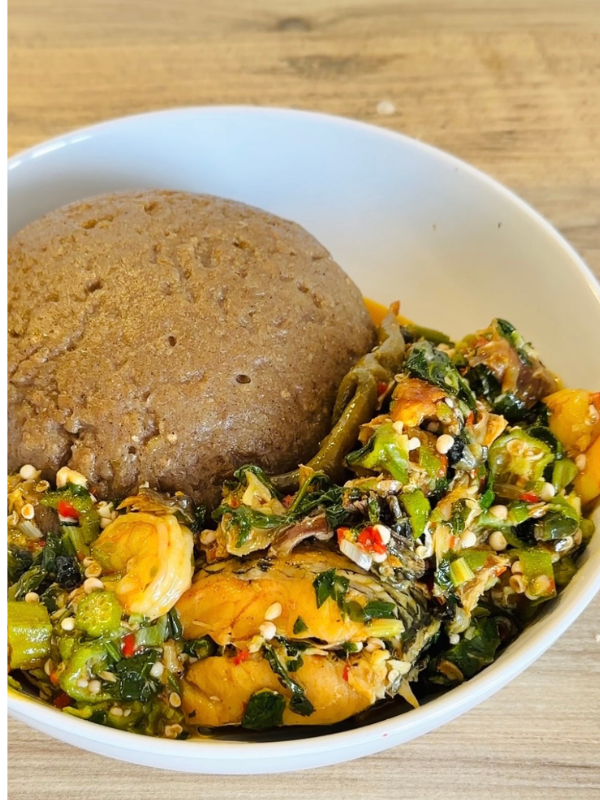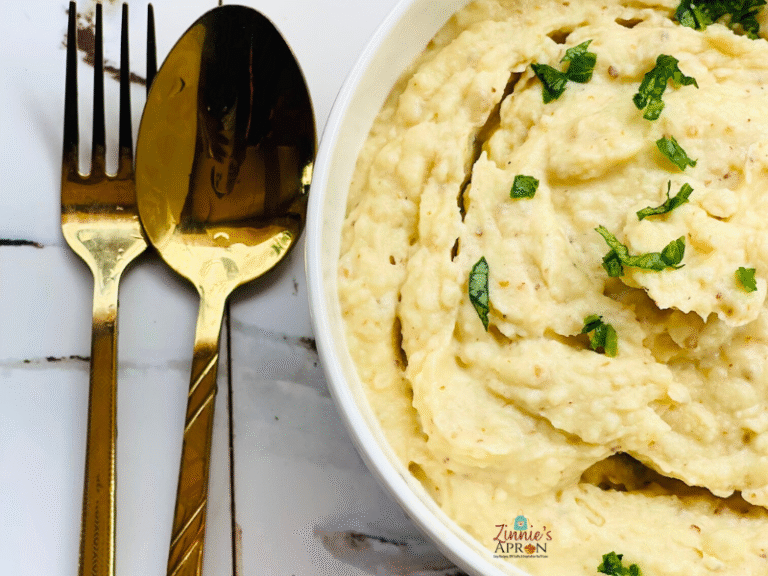If there’s one meal that truly hugs you from the inside out, it’s a pot of Okro Soup Recipe.
The smell alone, that rich mix of palm oil, locust beans, and smoked fish can pull everyone from the bedroom straight to the kitchen. Okro soup isn’t just food; it’s a feeling. It’s comfort, it’s warmth, and for many Nigerians, it’s home served in a bowl.
It’s thick, hearty, and packed with layers of flavor that just make you want to sit back and enjoy life. For me, it’s the perfect “feel good” food especially when the weather’s gloomy or you just want something homemade that hits differently.
In this hearty Nigerian okro soup recipe, I added a little ogbono to give it that extra body the kind that hugs your swallow just right. The best part? You can make it your own! Toss in beef, goat meat, fish, or even just a simple mix of stockfish and ponmo. It never disappoints.
And if you’re in a place where some of the ingredients are hard to find, don’t worry I’ll show you simple substitutes that’ll still give you that rich, authentic taste.
So, if you’re craving something hearty, flavorful, and deeply Nigerian, this okro soup recipe is that pot of comfort you’ve been waiting for.
Why You’ll Love This Hearty Nigerian Okro Soup Recipe
If there’s one thing Nigerians know how to do best, it’s making a soup that fills your stomach and your soul. This Hearty Nigerian Okro Soup Recipe is that one pot wonder that brings comfort with every scoop just like my Smoky One Pot Chicken and Rice – Nigerian Concoction Style
You’ll love it because:
It’s hearty and wholesome.
Every spoonful bursts with flavor from the mix of meats, fish, and the earthy blend of palm oil and ogbono. It’s not just soup it’s a full experience.
It’s protein-packed goodness.
From beef and goat meat to stockfish and catfish, this traditional okro soup is loaded with all the rich flavors that make Nigerian soups stand out.
It’s healthy and nourishing.
Okro (or okra) is full of fiber, vitamins, and natural goodness. Combine that with palm oil and greens, and you’ve got a nutritious meal that doesn’t compromise on taste.
It’s quick and flexible.
You can whip up this Nigerian-style okra soup in less than an hour. And the best part? You can adjust it to fit what’s available in your kitchen no stress, no drama.
It pairs beautifully with everything.
Whether it’s pounded yam, fufu, eba, or even rice (yes, rice lovers are welcome here ), this soup holds its own.
So, if you’ve been searching for a comfort food that feels like home, this Hearty Nigerian Okro Soup Recipe is it rich, spicy, and deeply satisfying.
Ingredients for Hearty Nigerian Okro Soup Recipe
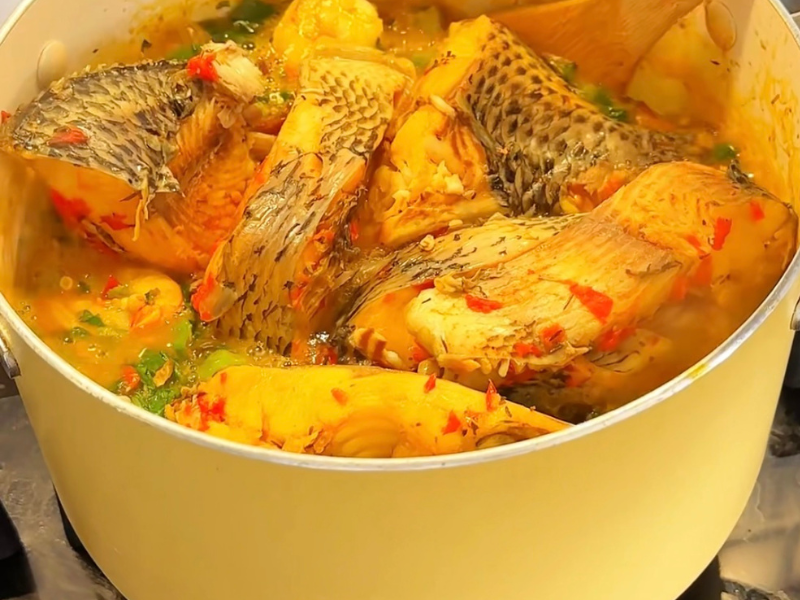
If you’ve ever tasted a well made Hearty Nigerian Okro Soup Recipe, you know it’s the perfect blend of comfort and flavor hearty, earthy, and rich in tradition. Here’s everything you’ll need to recreate it:
For the Fish
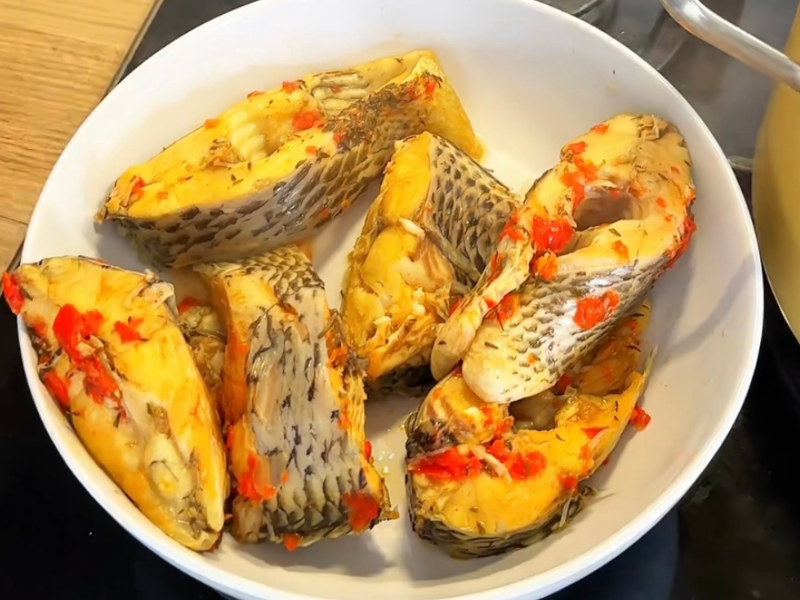
-
Fresh fish (any firm type like tilapia or catfish) — cleaned and cut into portions
-
1 teaspoon thyme
-
1 teaspoon Scotch bonnet pepper (Shombo) — adds a gentle heat and flavor kick
-
Salt to taste
Other Ingredients
-
2 tablespoons ground ogbono (ground wild mango seeds) — gives that smooth, slightly stretchy texture we love
-
½ cup palm oil — for richness and that deep golden color
-
1 small onion, finely chopped
-
2 cups fresh okro, sliced
-
1 tablespoon iru (locust beans) — adds that authentic, traditional depth
-
A handful of periwinkles (Isam) — for extra flavor and texture
-
2–3 seasoning cubes, or to taste
-
Salt as needed
-
Fresh spinach leaves, roughly chopped — adds color and freshness to the soup
Optional Add-ins
-
A spoon of crayfish powder for deeper flavor
-
A few chunks of beef or assorted meats if you want a heavier version
How to Cook Hearty Nigerian Okro Soup
There’s something deeply comforting about a pot of Nigerian okro soup bubbling away on the stove that thick, hearty texture, the aroma of palm oil, and the rich flavor from fish and spices that fill your kitchen. Let’s walk through it step by step so you can nail that perfect, flavorful pot every single time.
Step 1: Season and Cook the Fish
Start by seasoning your fresh fish with thyme, salt, Scotch bonnet pepper (shombo), and a pinch of seasoning cubes. Add a bit of water and let it cook gently until the fish becomes tender and infused with rich flavor.
Once it’s ready, remove it from the pot and set aside this fish will come back later to elevate your soup.
Pro Tip: Don’t rush the fish. Let it simmer on low heat so it soaks in all that flavor. This is what gives your okra soup that deep, savory base Nigerians love.
Step 2: Prepare the Ogbono Base
In another pot, pour in some water and allow it to come to a gentle boil. In a small bowl, mix your ground ogbono with a little palm oil just enough to create a smooth paste.
Once your water starts boiling, gently add the ogbono mixture while stirring continuously to prevent lumps. Keep stirring until the mixture thickens into that classic, stretchy texture.
Pro Tip: The secret to a good hearty Nigerian okra soup is stirring while the ogbono cooks that’s how you achieve that smooth, rich consistency without clumps.
Step 3: Add the Palm Oil and Okro
Now that your ogbono base is ready, add another spoon or two of palm oil for color and flavor. Then, stir in your grated okro.
Mix well and allow it to cook for a few minutes, but not too long you want it to retain a little crunch.
Pro Tip: For the perfect balance, let your okro cook just until it becomes slimy and blends with the ogbono overcooking will make it too soft and flat.
Step 4: Bring in the Flavor
At this stage, it’s time to add the rest of the soul of your Nigerian okra stew:
-
Add iru (locust beans) for that authentic local flavor.
-
Toss in your periwinkles (isam) for some seafood depth.
-
Sprinkle in crayfish and seasoning cubes to round out the taste.
Let everything simmer gently so the flavors combine beautifully.
Step 5: Add the Fish and Spinach
Finally, add your cooked fish back into the pot along with your spinach leaves. Gently stir to combine without breaking the fish apart.
Allow the soup to simmer for about 3–5 minutes, just enough for the greens to soften and the broth to thicken beautifully.
Pro Tip: Always add your vegetables last it keeps your traditional okro soup fresh and vibrant instead of dull and mushy.
Step 6: Serve and Enjoy
Once done, turn off the heat and serve hot with your favorite swallow eba, pounded yam, fufu, or semo all work perfectly.
For a modern twist, some people even enjoy it with rice (no judgment here flavor has no rules).
Pro Tips for the Best Hearty Nigerian Okro Soup Recipe
-
Chop your okro finely (or coarsely …your call!). The smaller you chop, the more that lovely “draw” or thickness you’ll get. If you like a lighter texture, slice them in bigger chunks.
-
Add the ogbono gradually. Mix it with a little palm oil first so it doesn’t clump up when it hits the heat. This trick keeps your soup silky and even.
-
Don’t overcook the fish. Fresh fish cooks quickly, so add it towards the end to keep it tender and juicy instead of falling apart.
-
Palm oil matters. A rich red palm oil gives that deep, earthy flavor that makes Nigerian okro soup taste like home. Don’t substitute it with vegetable oil if you want the real deal.
-
Layer your flavors. Start with your ogbono base, then add okro, iru, and periwinkles at different stages so the flavor builds naturally it’s what gives this soup that comforting depth.
-
Finish strong with greens. Add your spinach (or ugu leaves if available) at the very end so it stays bright and fresh, not soggy.
Ingredient Swaps and Variations
Making hearty Nigerian okro soup outside Nigeria can be a little tricky if you can’t find some traditional ingredients, but don’t worry I’ve got your back. Here are simple swaps that keep the soul of the dish alive while making it doable anywhere.
-
Ogbono substitute: Can’t find ogbono seeds (wild African bush mango seeds)? You can replace them with a small amount of ground flaxseed or okra powder. It won’t be identical, but it’ll help achieve that signature “draw” texture.
-
Periwinkles (Isam): These little seafood gems can be swapped with clams, mussels, or shrimp. They’ll bring that same briny bite that makes the soup rich and layered.
-
Palm oil: If red palm oil isn’t available, use a mix of olive oil and smoked paprika to mimic the color and slightly smoky flavor. But note nothing truly replaces real palm oil’s depth.
-
Spinach: Nigerian soups often use ugu (fluted pumpkin leaves), but spinach is an excellent alternative. You can also try kale for a heartier texture.
-
Iru (fermented locust beans): This is where a lot of the umami comes from. If you can’t get iru, add a dash of miso paste or fermented soybean paste it gives that deep, earthy taste without overpowering the soup.
-
Fish options: If fresh tilapia or catfish isn’t handy, go for salmon, cod, or snapper. They hold well in soups and soak up the flavors beautifully.
For a fun twist, try adding shrimp, beef tripe, or smoked turkey. Each version has its own charm from smoky to savory to seafood rich and they all bring new life to this Nigerian okro soup recipe.
FAQs About Nigerian Okro Soup Recipe
1. Can I make Nigerian okro soup without ogbono?
Absolutely. While ogbono (wild mango seeds) adds that stretchy, thick texture, you can skip it if you prefer a lighter soup. Just cook your okro a little longer to release its natural sliminess, or add more grated okro for a similar effect.
2. What’s the best fish for Nigerian okro soup?
Fresh fish like tilapia, catfish, or mackerel work beautifully they give the soup that deep, rich flavor Nigerians love. If you can’t find those locally, use salmon or cod as substitutes. They hold up well and still taste amazing.
3. How do I keep the okro from losing its “draw”?
The secret is not to overcook it. Add your chopped okro towards the end of cooking and stir gently. Over-stirring or cooking too long can break down the mucilage that gives it that signature stretch.
4. Can I use frozen spinach or other greens instead of fresh?
Yes, definitely. Fresh spinach gives that bright finish, but if you’re abroad or out of season, frozen spinach, collard greens, or kale can work just as well. Just thaw, squeeze out excess water, and add it at the end.
5. What can I serve Nigerian okro soup with?
Traditionally, it’s best with swallows like pounded yam, garri (eba), semovita, or amala. But it’s also delicious with rice, boiled yam, or even quinoa if you’re doing a fusion-style meal.
6. Can I make this okro soup vegetarian or vegan?
Sure! Just skip the fish and periwinkles, and use mushrooms or tofu instead for protein. Add a touch of smoked paprika for that “smoky Nigerian flavor” you’d normally get from fish.
7. How long does hearty okro soup last in the fridge?
It stays good for about 3 to 4 days if properly refrigerated. Just make sure the container is airtight to keep the aroma locked in and other fridge smells out.
Storage and Serving Tips for Hearty Nigerian Okro Soup
One thing about Nigerian okro soup — it somehow tastes even better the next day. The flavors settle, deepen, and that rich mix of fish, ogbono, and okro just gets bolder. So if you make a big pot (and trust me, you should), here’s how to store and serve it the right way.
How to Store It Properly
-
Refrigerate: Let the soup cool completely before storing. Pour into an airtight container and refrigerate for up to 3–4 days. The texture stays just right if you warm it gently.
-
Freeze: For longer storage, divide into meal-size portions and freeze for up to a month. When ready to eat, thaw overnight in the fridge, then reheat slowly on low heat. Avoid microwaving too long so the okro doesn’t lose its natural “draw.”
-
Reheat Tip: Always reheat with a little splash of water or broth to keep it from thickening too much. Stir occasionally while it warms up that’s the secret to keeping the texture silky.
Serving Suggestions
Serving hearty Nigerian okro soup is all about comfort and tradition. It pairs beautifully with:
-
Swallow foods: Pounded yam, eba, semovita, fufu, or amala — the classics that make the soup shine.
-
Rice or boiled yam: If you’re not big on swallow, serve it with hot white rice or soft yam chunks for a satisfying twist.
-
Avocado or fried plantains: For a fun fusion touch, add slices of creamy avocado or golden fried plantains on the side it’s a delicious blend of textures.
For the best experience, serve it steaming hot, with a hint of palm oil glistening on top and a sprinkle of fresh spinach or scent leaves just before eating. That’s how to truly enjoy this authentic Nigerian okro soup in all its hearty glory.
Images courtesy Of The KNIs
You May Also Like:


